
Chittlehampton is a village and civil parish in the North Devon district of Devon, England, about 7 miles (11 km) south-west of Barnstaple. At the 2001 census, the parish had a population of 820.

John Rolle, 1st Baron Rolle was a British politician and peer who served as a Member of Parliament in general support of William Pitt the Younger and was later an active member of the House of Lords. His violent attacks on Edmund Burke and Charles James Fox in the early 1780s led to his being the target for satirical attack in the Rolliad. He was colonel of the South Devon Militia and was instrumental in forming the Royal 1st Devon Yeomanry and the North Devon Yeomanry.
Robert Edward Trefusis was the first suffragan Bishop of Crediton from 1897 to 1930.
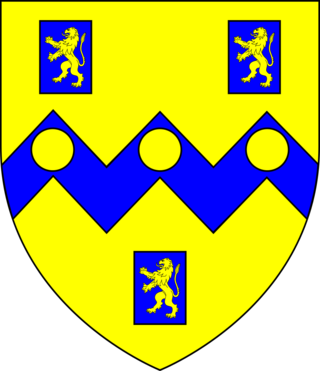
Sir John Rolle, KB, of Stevenstone, Devon, was an English landowner, Sheriff of Devon in 1682 and MP for Barnstaple (1660) and for Devon (1661–1679). The Travel Journal of Cosimo III de' Medici, Grand Duke of Tuscany (1642-1723) states of him: "This gentleman is one of the richest in the country, having an estate of six thousand pounds sterling per annum, besides a considerable property in ready money".
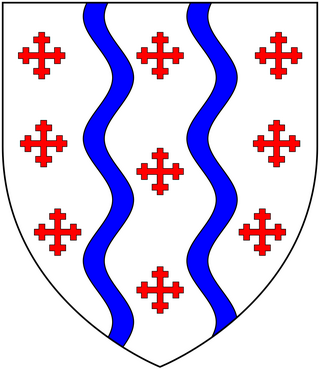
John II Dodderidge (1610–1659) of Bremridge in the parish of South Molton, Devon, was a lawyer who was elected MP for Barnstaple in 1646 and 1654, for Bristol in 1656 and for Devon also in 1656, and chose to sit for Devon, but was prevented by Oliver Cromwell from taking his seat.
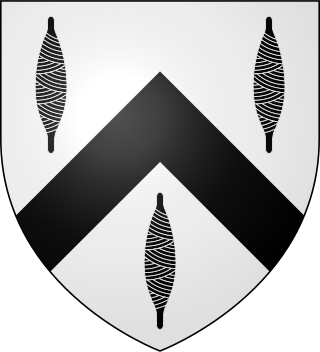
John Trefusis lord of the manor of Trefusis in the parish of Mylor in Cornwall, was an English politician who sat in the House of Commons from 1621 to 1622.

Hon. Mark George Kerr Rolle, of Stevenstone, St Giles in the Wood, Devon, was High Sheriff of Devon in 1864, a DL of Devon and High Steward of Barnstaple.

Stevenstone is a former manor within the parish of St Giles in the Wood, near Great Torrington, North Devon. It was the chief seat of the Rolle family, one of the most influential and wealthy of Devon families, from c. 1524 until 1907. The Rolle estates as disclosed by the Return of Owners of Land, 1873 comprised 55,592 acres producing an annual gross income of £47,170, and formed the largest estate in Devon, followed by the Duke of Bedford's estate centred on Tavistock comprising 22,607 with an annual gross value of nearly £46,000.

Samuel Rolle (1669-1735) of Hudscott, Chittlehampton, Devon, was MP for Barnstaple between 1705 and 1708. He was a member of a cadet branch of the influential Rolle family of Stevenstone.

Heanton Satchville was a historic manor in the parish of Petrockstowe, North Devon, England. With origins in the Domesday manor of Hantone, it was first recorded as belonging to the Yeo family in the mid-14th century and was then owned successively by the Rolle, Walpole and Trefusis families. The mansion house was destroyed by fire in 1795. In 1812 Lord Clinton purchased the manor and mansion of nearby Huish, renamed it Heanton Satchville, and made it his seat. The nearly-forgotten house was featured in the 2005 edition of Rosemary Lauder's "Vanished Houses of North Devon". A farmhouse now occupies the former stable block with a large tractor shed where the house once stood. The political power-base of the Rolle family of Heanton Satchville was the pocket borough seat of Callington in Cornwall, acquired in 1601 when Robert Rolle purchased the manor of Callington.

George Rolle of Stevenstone in the parish of St Giles in the Wood near Great Torrington in Devon, was the founder of the wealthy, influential and widespread Rolle family of Devon, who by 1842 had become the largest landowners in Devon with about 55,000 acres according to the Return of Owners of Land, 1873 in the person of Hon. Mark Rolle, the adoptive heir of John Rolle, 1st Baron Rolle. He was a Dorset-born London lawyer who in 1507 became Keeper of the Records of the Court of Common Pleas and was elected as a Member of Parliament for Barnstaple in 1542 and 1545. He became the steward of Dunkeswell Abbey in Devon, and following the Dissolution of the Monasteries he purchased much ex-monastic land in Devon. Not only was he the founder of his own great Devonshire landowning dynasty but he was also an ancestor of others almost as great, including the Acland baronets of Killerton, the Wrey Baronets of Tawstock and the Trefusis family of Trefusis in Cornwall now of Heanton Satchville, Huish, later Baron Clinton, heirs both of Rolle of Heanton Satchville, Petrockstowe and of Rolle of Stevenstone.
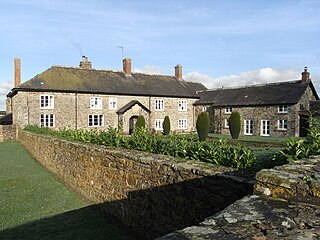
Brightley was historically the principal secondary estate within the parish and former manor of Chittlehampton in the county of Devon, England, situated about 2 1/4 miles south-west of the church and on a hillside above the River Taw. From the early 16th century to 1715 it was the seat of the Giffard family, whose mansion house occupied the moated site immediately to the west of the present large farmhouse known as Brightley Barton, a Grade II listed building which incorporates some elements of the earlier house. It is not to be confused with the 12th-century Brightley Priory near Okehampton.

John Rolle (1522–1570) of Stevenstone, in the parish of St Giles in the Wood, near Great Torrington, Devon, was the eldest son and heir of George Rolle, MP, founder of the great Rolle family of Stevenstone, by his second wife Eleanor Dacres. Three monuments survive in memory of his immediate family in the churches of St Giles in the Wood and Chittlehampton.

Denys Rolle was a British politician and landowner who was an independent member of parliament for Barnstaple between 1761 and 1774. He inherited a large number of estates and by the time of his death he was the largest landowner in Devon. He was a philanthropist and generous benefactor to charities and religious societies.

John Rolle (1679–1730) of Stevenstone and Bicton in Devon, was a British landowner and Tory politician who sat in the English House of Commons from 1703 to 1705 and in the British House of Commons from 1710 to 1730. He declined the offer of an earldom by Queen Anne, but 18 years after his death his eldest son was raised to the peerage in 1748 by King George II as Baron Rolle.
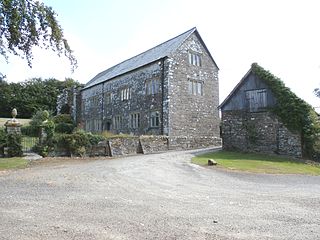
Bremridge is a historic estate within the former hundred of South Molton in Devon, England. It is now within the parish of Filleigh but was formerly in that of South Molton. It is situated 8 miles north-west of South Molton. Since the construction of the nearby A361 North Devon Link Road direct access has been cut off from Bremridge to Filleigh and South Molton. The surviving wing of the mansion house built in 1654 is a Grade II* listed building. Bremridge Wood is the site of an Iron Age enclosure or hill fort, the earthwork of which is situated on a hillside forming a promontory above the River Bray. In Bremridge Wood survives a disused tunnel of the former Great Western Railway line between South Molton and Barnstaple, much of the course of which has been used for the A361. The tunnel is 319 yards long and was identified as "Bremridge Tunnel" in the 1889 Ordnance Survey map but as "Castle Hill Tunnel" in subsequent editions.

Hawkridge in the parish of Chittlehampton in North Devon, England, is an historic estate, anciently the seat of a junior branch of the Acland family which originated at nearby Acland, in the parish of Landkey and later achieved great wealth and prominence as the Acland Baronets of Killerton, near Exeter. The former mansion house is today a farmhouse known as Hawkridge Barton, a grade II* listed building. The Devon historian Hoskins (1959) stated of Hawkridge: "Externally there is nothing remarkable except a decaying avenue of ancient walnuts, so often the first indication of a 16th or 17th century mansion". The interior contains a fine plaster heraldic overmantel showing the arms of Acland impaling Tremayne, representing the 1615 marriage of Baldwin Acland (1593–1659) of Hawkridge and Elizabeth Tremayne.

The Manor of Otterton was a medieval manor in East Devon, England.
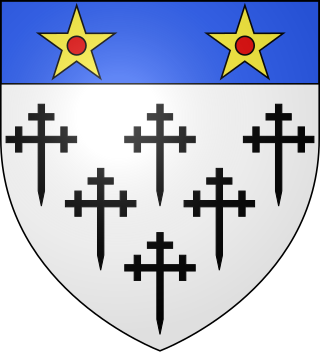
Clinton Devon Estates is a land management and property development company which manages the Devonshire estates belonging to Baron Clinton, the largest private landowner in Devon, England. Lord Clinton is of the Fane-Trefusis family, and is seated at Heanton Satchville in the parish of Huish, in Devon. The organisation's headquarters are situated on part of the estate at the "Rolle Estate Office" in the Bicton Arena at East Budleigh, near Budleigh Salterton, East Devon.
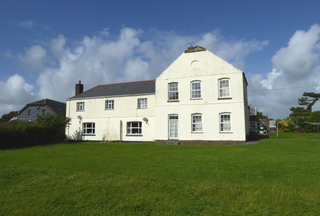
Webbery is an historic manor in the parish of Alverdiscott in North Devon, England.


































